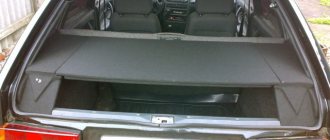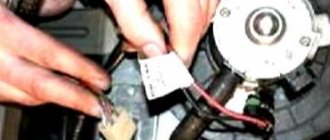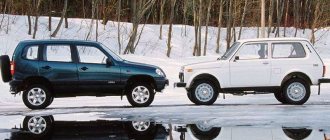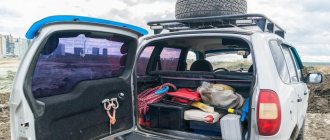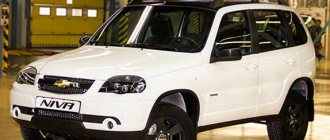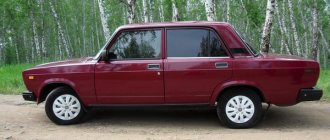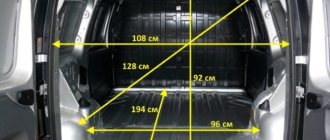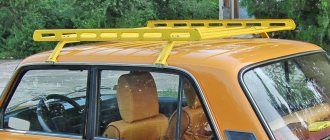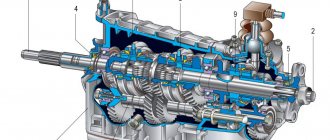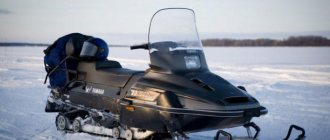Chevrolet Niva dimensions, dimensions, volumes, Chevrolet NIVA 4x4 ground clearance, trunk
The dimensions of the Chevrolet Niva classify this 5-door crossover as a very compact car.
In fact, the length of the Chevrolet NIVA does not exceed 4 meters. However, such compact dimensions, combined with high ground clearance, which is more than 20 centimeters, and small overhangs, make the small crossover ready for any off-road obstacles. In the photo at the beginning of the article you can see all the main linear dimensions of the Chevy Niva . I would like to immediately note that the official dimensions given by the manufacturer and actual measurements may give different results.
Let's say the clearance or ground clearance of a Chevrolet Niva can vary from 20 to 24 centimeters. The difference depends on where you measure. For example, the lowest point in the Chevrolet NIVA is in the rear, under the bridge. You can measure the ground clearance of the Shnivy under the engine protection in the front. In addition, the manufacturer itself allows the installation of both 15 and 16-inch wheels on the car; add off-road high-profile tires to them and the ground clearance will be even higher.
Below are more detailed characteristics of the dimensions of the Chevy Niva .
- Length – 3919 mm (with spare wheel 4056 mm)
- Width – 1,800 mm (with mirrors 2120 mm)
- Height with/without rails – 1690/1652 mm
- Curb weight – 1410 kg
- Gross weight – 1860 kg
- Wheelbase – 2450 mm
- Front and rear wheel track – 1466/1456 mm, respectively
- Trunk volume – 320 liters
- Trunk volume with seats folded – 650 liters
- Fuel tank volume – 58 liters
- Ground clearance of Chevy Niva – 220 mm
- Tire size – 205/75 R15 or 205/70 R15 or 215/65 R16
As for capacity, five adult men in the Chevrolet NIVA, to be honest, will be cramped. The wheelbase, which determines the spaciousness in the cabin, is only 2450 mm. Therefore, traveling long distances in a large group may not be enjoyable.
The trunk of the Chevrolet Niva is relatively small, only 320 liters. However, if you fold the seats in the Shnivo, you get 650 liters of volume. A photo of the trunk with the rear seats folded is attached, see above.
The problem of lack of space is solved by roof rails, where you can install an additional luggage rack. But it is worth considering the fact that in the basic version the Chevy Niva simply does not have roof rails. Therefore, before buying a car, you should consider whether you need an additional roof rack.
Expedition trunk
If the car owner often travels or transports large items, it is recommended to tune the roof rack.
Tuning elements:
- The loading basket is an expeditionary trunk with sides, which ensures a comfortable arrangement of things inside the basket. It has a reinforced design, which increases its load capacity to 200 kilograms.
- Two crossbars. Installed transversely to the car parallel to each other. You can also install cross members along the car. Intended for transporting things that are of considerable length (fishing gear, skis, etc.).
- Autobox. The trunk is made in the form of a closed element, which is characterized by the presence of internal compartments. Thanks to the tightness of the car box, things that are not resistant to ultraviolet radiation and precipitation can be transported in it. It is recommended to purchase a trunk with a lock that will limit unauthorized access inside.
The process of installing the trunk depends on the selected model. Some of them have a mount that requires removing the interior trim:
- There are special slots on the roof of the car into which you need to insert a plastic key and turn it 90 degrees. Use the key to move clockwise until it clicks.
- The support cover is removed, under which there are slots and holes. Fastening elements are installed in them.
- Before completing the installation process of the trunk, the cam is adjusted.
- At the next stage, the supports are fixed. They are adjusted so that the pillows are located as close to the middle as possible.
- To ensure the highest quality fixation, use a special L-shaped key. Proceed with caution - overdoing it will damage the metal.
- Plastic plugs are installed on top of the arcs and the support cover is fixed.
- At the last stage of installation, the secure fixation of all system components is checked.
Dimensions and features of the Chevrolet Niva trunk
A worthy model among Russian off-road passenger cars is the Chevrolet Niva. However, it does not have a number of disadvantages. For example, there is an established opinion among drivers that the Chevrolet Niva has practically no trunk. Let's figure out whether this is a lie or a real disadvantage of the domestic SUV.
Chevrolet Niva is a small-sized five-door crossover that is suitable for driving in the city and off-road. On the market since 2002, restyling took place only once. It differs from other Chevrolet models assembled in Russia in that 90% of all components are domestically produced. A remarkable fact: in 2009, this model received the award, awarded annually by the best auto magazines, “SUV of the Year 2009” in the “Premiere of the Year” and “SUV” categories.
Owner reviews
On the Chevrolet Niva you can find a huge number of opinions of a different nature, but basically they are all similar in general terms. For example, Vladimir from Voronezh writes: “I bought a Chevrolet Niva in 2016. I didn’t really have to choose, rather it was a necessity, because the last car was a foreign car, but the years have taken their toll, and repairs from an official dealer are not cheap. I took the pre-maximum configuration and in this version received air conditioning, an alarm system, parking sensors, music and some other goodies. Of course, after a foreign car the feeling was not the same, it took a long time to get used to.
No matter what anyone says, the car is reliable; in 2.5 years there were only two breakdowns, and even those were fixed under warranty. I drive mainly around the city, in the summer to the dacha and fishing, I treat the car with care. I don’t write about changing consumables on time, that’s already clear. Among the advantages for myself, I would note a high and comfortable seating position and good interior heating in winter. And its main advantage is its cheapness in everything. The Chevrolet Niva is not a priority for car thieves, there is no fear for it, and if something happens, repairs are cheap. The disadvantages are the lack of dynamics, which is not surprising with such an engine, there is no adequate sound insulation and too much fuel consumption, especially with the air conditioning running.”
Pavel, Barnaul: “Maybe I was just unlucky, but after 15,000 kilometers problems began with the transmission, the front axle howled, there was a knock in the gearbox, the phase sensor and the lock limit switch failed. The engine is sorely lacking, and even the turn signal has fallen off, it’s unclear how to glue it to the body. The main advantage is cross-country ability and low price of spare parts. There are many more disadvantages. And the low quality of components, and violation of assembly technologies, plus we can add to this the chronic problems of all Nivas.”
Semyon, Syktyvkar: “As for me, the price is very high. The quality of assembly and components invariably falls, and the cost, on the contrary, rises. It seems that the manufacturer listens to customer recommendations, but does exactly the opposite. For me, the only advantage is the high ground clearance, otherwise there are continuous disadvantages, starting with door locks and ending with an outdated and worthless engine.”
Despite many disadvantages, the Chevrolet Niva was still able to become the people's SUV, becoming a worthy successor to the 2121 and other modifications. This is largely due to high maintainability, low cost of spare parts and the lack of a worthy alternative. The concept of the production version of the updated Chevrolet Niva has already been presented; whether the promising new product will reach the production line is still unknown.
A worthy model among Russian off-road passenger cars is the Chevrolet Niva. However, it does not have a number of disadvantages. For example, there is an established opinion among drivers that the Chevrolet Niva has practically no trunk. Let's figure out whether this is a lie or a real disadvantage of the domestic SUV.
First generation
The model that replaced the AvtoVAZ Niva and VAZ-2123 Niva is the VAZ-21236. Today, official manufacturers have announced seven vehicle configuration options: L, LC, GL, LE, GLC, LE+, SE. The description of the car and its dimensions in the simplest basic version are as follows:
- length is no more than 4 m;
- height up to 2 m (including possible additional roof rack);
- weight about 1.5 tons;
- the fuel tank holds 58 liters;
- clearance from 20 to 24 cm;
- the width including side mirrors is just over 2 m, the body without mirrors is 180 cm;
- The trunk volume of the Chevrolet Niva is 320 liters, and if the rear seats are folded down it is 650.
The trunk with the seats folded has a volume of 650 liters. This is a sufficient cubic capacity for comfortable placement of things during a trip to nature if the family consists of two people.
The crossover is designed for four passengers and a driver. Based on reality, travel for four adults in this car is comfortable, but for five it’s already a bit cramped. But let's return directly to our topic - the trunk. Its parameters:
- height – 930 mm;
- depth – 680 mm;
- if you remove the seats, the depth will be 1230 mm.
The trunk on the Niva cannot be called huge. But its small size is partially compensated by the ergonomics of the space. Simply fold the rear seats and the space doubles. In addition, the LE, GLC, LE+, SE trim levels are equipped with roof rails. They can be installed on the roof and leave it at that, or you can place an additional luggage box there.
Installation
In most cases, installation is carried out independently. It is better to mount expeditionary racks with the help of a friend, since it will be much easier to do it with 4 hands.
Focus on the features of the selected trunk. In some models, the fastening is made there, so that you have to remove the trim elements in the cabin. Otherwise, installation does not involve any complex manipulations. The process looks something like this.
- There are special sockets on the roof of the Chevrolet Niva into which a plastic key is inserted. It rotates 90 degrees. You need to move clockwise. When it clicks into place, the goal is achieved;
- Now the support cover is removed. The resulting slots or holes are intended for installing fasteners there;
- Adjust the cam position before completing installation work. Otherwise, difficulties may arise later;
- Next we fix the supports. Install them so that the cushions are as close as possible to the middle, that is, the center of the car roof;
- To make the fixation as secure as possible, use a special L-shaped key. But don’t use your heroic strength too much, otherwise I don’t know how much you can twist. The main thing is that everything is strong, but also do not damage the metal;
- The top of the arcs are closed with plugs made of plastic. On some models, these plugs are short-lived and often fall out. Therefore, read reviews about luggage racks, take into account all their strengths and weaknesses;
- Proceed to fix the support cover. This is not difficult to do;
- When installation is complete, check again that all fasteners are fully tightened.
Installation may vary slightly depending on the roof rack selected. Therefore, rely on the factory installation instructions. Dismantling is carried out in the same way, only, as you understand, in the reverse order of your actions.
Did you think this was where we would start saying goodbye to you? Well, I do not. You won't wait. First, I will tell you about another option for the trunk. It's like a trunk within a trunk that you access when you open the rear tailgate.
Second generation
A long and unfinished epic is the history of the second generation Chevrolet Niva. Back in 2014, the concept of a new model was prepared, and it was successfully tested on the roads of Italy and Sweden. After which the release was scheduled for the winter of 2015. But the plans were disrupted by the financial crisis, shifting the sales deadline to the winter of 2021, and in February 2018 the project was once again suspended.
Today it is known that the changes will affect engine power and external parameters of the car, but will bypass indicators characterizing capacity. The second generation promises potential buyers:
- body dimensions: length will increase slightly to 4.316 m, width will increase by 30 mm;
- the fuel tank volume will be 62 liters as opposed to the previous 58;
- trunk volume in liters – 355 instead of the previous 320.
In the Chevrolet Niva, the trunk volume will only slightly expand. The rear seats can still fold down to improve cargo space. In some trim levels it is planned to use roof rails. It should be noted that the angularity of the new Niva could theoretically affect the usable volume in which luggage can be placed.
Engine specifications and other parameters
The Chevrolet Niva has been produced since 2003, but during this time no new power plant has appeared under the hood that would meet the requirements for an SUV engine. Moreover, this engine migrated from the Niva 2121, albeit after minor modernization. In this case, the manufacturer focused on the reliability and unpretentiousness of AvtoVAZ’s old developments.
The engine has an in-line layout, a four-cylinder unit with a displacement of 1.7 liters produces no more than 80 liters at 5200 rpm. With. The engine complies with Euro-4 requirements: it is a 16-valve engine with distributed injection, an injector, i.e. nothing new has appeared in it. For a relatively heavy Niva Chevrolet car, this is a frankly weak and obsolete power unit.
The Niva's engine is paired with a five-speed manual transmission. According to the manufacturer, this allows you to accelerate the car to a maximum of 140 km/h, and acceleration from zero to hundreds takes 19 seconds, which, of course, is a lot.
| Where exactly |
For 100 kilometers
From 2006 to 2008, the Chevrolet Niva was produced on a limited basis with the Opel Z18XE power plant in the FAM-1 configuration.
This 1.8-liter engine had a power of 122 hp. With. and was paired with a five-speed Aisin manual transmission, which had a built-in transfer case from the Suzuki Grand Vitara. This modification was not in high demand among buyers, partly due to its high cost. Therefore, mass production was discontinued, and in just over two years of production, no more than a thousand copies were sold.
Features of luggage compartments
To summarize, let’s say that the Niva’s trunk is really small in volume – less than 400 liters. But due to the space freed up after the rear seats are removed, it becomes more spacious. Railings became a bonus for some models. You can finish the conversation about the features of the Chevy trunk with a simple comparison with the Granta liftback.
With a volume of 440 liters in the Granta's trunk, its capacity, as practice shows, is significantly lower due to the peculiarities of the geometry of the space. The square trunk of the Niva turns out to be much more rational to use than the Grant one, which is more voluminous in terms of technical characteristics, but is “cut off” by the inclined glass of the door.
The car does not have a truly spacious trunk. Therefore, before purchasing, you should decide how important this criterion is for you, and choose a car model based on this.
Current options
Choosing a device based solely on a photo is not the best option. And I advise assembling it with your own hands only to people with sufficient experience. After all, for self-assembly you need to be able to create drawings, possess welding skills, and adhere to millimeter accuracy.
That’s why Niva owners usually choose ready-made factory options. The price is not that high, but you have a full-fledged roof rack at your disposal. Buy decent roof racks for roof rails. On average, you will need to pay 2 thousand rubles for it. There are cheaper models, but buying them involves downright risk. Often these are cheap, low-quality structures that will begin to rust after the first rain.
Chevrolet Niva
Both cars are frameless, with five-door station wagon bodies typical of all-wheel drive vehicles. The Duster has a longer wheelbase - 2673 mm versus 2450 mm for the Chevrolet Niva. It is clear that the additional centimeters allow passengers and luggage to be more comfortably accommodated, and also provide a bonus for stability and smoothness. However, off-road, the plus turns into a minus, significantly worsening the geometric cross-country ability.
The only Chevy engine is capable of producing only 80 horsepower and 127.5 Nm - it won’t show off its dynamics on the highway. And off-road, all hope lies only in the “wide” transmission.
“Duster” is richer in this regard. Three engines to choose from, one of them diesel. By the way, both the younger ones - both the petrol (1600) and the diesel (1500) - are more powerful than the Nivov 1700, and even richer in torque. The power unit is on a subframe, which means less vibration is transmitted to the body.
In terms of transmission, the Niva is a true all-terrain vehicle. The transfer case gives this car two full five-speed rows of gears. And in particularly difficult conditions, locking the center differential helps. Crosspieces on cardan shafts are a thing of the past, giving way to CV joints. Thus, nothing needs to be injected during operation.
The six-speed Duster is a half solution for serious off-road conditions (mud, sand and deep snow). In these conditions, you can at least move forward on the first lower gear, but you won’t be able to go back. Due to lack of torque on the wheels, the clutch will burn out. And the switching pattern with starting on hard roads from the second is not the most convenient. It was easier to remove the low gear from the general row and hide it under the flag - opposite the rear one. Then the asphalt part of the gearbox would turn into a five-speed gearbox with conventionally spaced steps.
If necessary, the electromagnetic clutch automatically turns the car into all-wheel drive - quite convenient. However, if it slips for a long time, for example, in deep snow, it will definitely overheat and for some time transfer all the hardships of fighting off-road conditions to one axle.
The car suspensions are completely different. The Niva has an independent front with parallel levers. The design is traditional for such machines - as they say, time-tested. This ensures a smooth ride at high speed and holds the impact on rough terrain.
The rear suspension is dependent. The design, one might say, is ancient: a beam with five rods (four longitudinal and one transverse) is familiar from the Zhiguli. A special feature of this suspension is its constant ground clearance.
The Duster has a modern and more passenger-friendly McPherson in front. Good on relatively smooth roads, but not durable enough off-road. It is this suspension that provides easy handling with clear reactions and a high smooth ride.
The brakes on the Niva are not the most modern. Disc in front, drum in back. The Duster's front brakes are ventilated discs, more effective at high speeds. The rear ones are drum-type, with a diameter smaller than that of the Niva, which shifts the load to the front ones.
The steering on both cars is power-assisted, which eats up engine power even when the wheels are in the “straight” position.
So, the Chevrolet Niva is a real all-terrain vehicle. Its inherent disadvantages (modest trunk, increased noise and vibration) are due to its purpose and design features.
“Duster”, translated from English as “duster”, exactly corresponds to the name. This is a more comfortable front-wheel drive passenger car with a temporarily connected rear axle. Spacious, with large wheels and good geometric cross-country ability, which allows it to dust on dirt roads more confidently than ordinary passenger cars. But off-road it can’t keep up with the Niva.
Characteristics of suspension and other systems
The Chevrolet Niva does not belong to the classic frame SUVs, since the body is the load-bearing vehicle here. The front has a standard independent suspension with double wishbones of the MacPherson type. At the rear there is a spring dependent suspension with hoses. Disc brakes are installed on the front axle. On the rear, as on any budget car, the Chevrolet Niva is equipped with drum brakes. To increase comfort, the braking system is equipped with a vacuum booster, and in top trim levels it has an auxiliary anti-lock braking system ABS.
The steering mechanism is rack and pinion, supplemented by a hydraulic booster. Regardless of the configuration, any modification of the Chevrolet Niva is equipped with a permanent all-wheel drive mechanism with a center differential lock and a transfer case operating in two ranges. Taking into account the high ground clearance, this system provides good off-road performance. In general, the technical characteristics of the Chevrolet Niva leave much to be desired.
The car is stable when cornering and can tow additional cargo on a trailer with a total weight of no more than 1.2 tons.
CHEVROLET NIVA
1. The design of the rear suspension guide vane is not the best. When the suspension is compressed, the bridge moves to the left, and when rebound, it moves to the right:
2. From below, the power unit is covered with “local” narrow protection. It protects the engine sump from collision with an obstacle, but the suspension elements and axle shafts are not covered by anything from dirt and snow:
3. Everything that can be damaged is raised above the side members - a kind of limiter when the bottom of the car comes into contact with the ground:
4. The rear axle of the Niva is a simple but durable design used on serious all-terrain vehicles. The fuel tank is hidden inside the body:
5. The fuses are accessible from the passenger compartment, but the block cover is secured with screws for a screwdriver:
6. Steering rods are located at the “back of the head”. Even off-road, the chances of damaging them are minimal:
7. The Niva engine is located longitudinally, which also determines the placement of the units: the transfer case is behind the gearbox. The generator is raised high; it is not in danger of dying in a deep puddle. The oil filter is accessible from above:
8. The transfer case turns the Niva into a full-fledged all-terrain vehicle:
RENAULT DUSTER
1. Multi-link rear suspension of a modern design is the key to a smooth ride on bad roads. However, it is vulnerable off-road. On rear axle shafts, CV joint covers are not protected from mechanical damage:
2. The rear axle gearbox is mounted on a subframe - less vibration goes to the body. An electromagnetic clutch is attached to the gearbox, which controls the connection of torque. For serious off-road use, the design is toy-like: I tore off the wires and was left without all-wheel drive! An unprotected fuel tank hangs here:
3. The driveshaft going to the rear axle is connected to the gearbox through an angular gearbox. When driving, it rotates constantly, even when the transmission is in front-wheel drive mode:
4. The protection of the power unit here is much wider than Niv’s, therefore it performs its functions better - it protects the power unit from possible damage and from snow and dirt:
5. The power unit is installed transversely, at the bottom of the gearbox there is a power take-off shaft for the rear axle. The generator is raised high, deep puddles are not scary for it. The oil filter is more accessible from below - the cooling system hoses block it from above:
6. The radiator of the Duster cooling system is in a high-risk zone:
7. The fuse box is hidden at the end of the instrument panel and is only accessible when the door is open:
Still, the exhaust system pipes and mufflers in the tail of the car hang too low - on off-road they are easy to at least crush:
RENAULT DUSTER
— The 4x4 version is available with 1.6 liter (102 hp, 145 Nm) and 2 liter (135 hp, 195 Nm) petrol engines or with a 1.5 liter diesel engine (90 hp, 200 Nm), all paired with a 6-speed manual. The front-wheel drive version is equipped only with gasoline engines - 1.6 liters with a five-speed gearbox or 2 liters with an automatic transmission.
— Load capacity 500 kg, trunk volume 408 l (475 l for the 4x2 version). With the rear seats folded - 1570 liters (1636 liters for the 4x2 version).
— The fuel tank holds 50 liters.
— Ground clearance 205 mm.
- Power steering, anti-lock braking system, driver's airbag - in the basic "Authentic" configuration, side airbags and a passenger airbag - in the coolest "Luxury Privilege". There are two intermediate configurations - “Expresion” and “Privilege”.
— Price: 4x4 — from 499,000, 4x2 — from 449,000 rubles.
— Warranty — 3 years or 100,000 km, excluding consumables. The clutch mechanism, release bearing and catalytic converter are covered by a 30,000 km warranty. For front and rear shock absorbers, the warranty limit is 2 years or 30,000 km. The warranty on tie rods and ends, struts and stabilizer bushings, silent blocks, rubber-metal bearings and ball joints of suspension parts and power units is limited to 50,000 km. The battery warranty is valid for 2 years or 60,000 km.
— Maintenance frequency is 15,000 km.
OFF-ROAD
Next to the Niva gearbox lever there is a lever that controls the transfer case. By moving it back (position H) the higher row of the transfer case is switched on, and forward (to position L) – the lower row; between them is “neutral”, in which torque is not transmitted to the wheels. The lower row allows you to increase the overall transmission ratio (torque at the wheels) in any gear by 2.1 times. By moving the lever to the left (in any position), the center differential is blocked: a rigid connection is created between the front and rear axles. Helps on slippery ascents and descents, on very rough terrain, when there is a high probability of one of the wheels hanging out, as well as when starting off, when the wheels of one of the axles are on a surface with a lower coefficient of adhesion than under the wheels of the other. It is strictly forbidden to use a blocker on roads with a high coefficient of traction.
The all-wheel drive Duster transmission has three modes. You can select them by turning the large “button” on the console.
2WD - front wheels only. Used for dry roads with a high coefficient of traction.
Chevrolet Niva interior and trunk dimensions
The model was restyled in 2009, and was developed by the design studio Stile Bertone. The Chevrolet NIVA is available in 5 trim levels: L, LC, LE, GLS, GLC. In May 2015, the range of model trim levels was expanded with the LE+ version, created on the basis of the GLC version. The car received air conditioning, a full safety package, Continental Cross Contact tires with K&K Camelot wheels, as well as rear bumper protection with a towbar and unpainted moldings. Since October 2015, all cars have been equipped with modernized Euro-5 engines.
Chevrolet Niva (VAZ-21236) - video test drive
List of changes in relation to the old Chevrolet Niva
1. Three-post roof rails on all cars, according to the manufacturer, can withstand 100 kg (Only on GLS and GLC). 2. Front bumper combined with grille. There is a pad at the bottom of it; in case of damage, you do not have to replace the entire bumper. 3. Three-spoke steering wheel manufactured by TRW (Portugal) 4. New alloy wheels. 5. A large new three-zone front lamp for interior lighting; in the luxury package there is also a two-zone rear lamp and such a new option as an eyeglass case. 6. New rear bumper with a corrugated plastic lining that helps with unloading and loading.
7. Plastic body kits with a “Bertone Edition” nameplate on the sidewall. It includes wider side mods and added wheel arch linings. In the basic L/LC configuration they are not painted, in the GLS/GLC configuration they are painted in body color. 8. Lens headlights. 9. New taillights. 10. One of the ignition keys supplied contains a folding mechanism and is equipped with a remote alarm control panel. 11. Open box and two cup holders between the seats + one near the cigarette lighter for installing an ashtray. 12. The control units for electric mirrors and heated seats have been moved to the lower part of the center console. 13. Between the transmission levers there is a portable ashtray - a glass with a lid. Only in the Luxury package. 14. Mirror in the sun visor 15. New rear seats. Recessed head restraints, which do not obstruct rearward visibility, allow the rear seat to be folded without first removing the head restraints. 16. The rear driveshaft is NOT a CV joint. There are no mechanical changes at all! 17. Another glass gluing technology
18. The ceiling trim has changed. 19. New large “Butterfly” on the radiator grille 20. Changed “eyelashes” of the headlights 21. Another electrical package (according to unverified data from Priora, to be confirmed) 22. The knobs on the gearbox and transfer levers are different - large and silver. There is no switching circuit on them. Although there are also black ones. 23. Silver trim for the glove compartment. Only in GLSGLC configuration. 24. The interior mirror is glued to the glass. 25. Windshield with stripe. 26. There is a hood in the rear bumper (which prevents the interior from fogging). 27. The leatherette used in the upholstery comes from Germany. 28. Changes in interior ventilation, as a result of which the problem with windshield fogging was solved. An element of this change is the ventilation grilles (“gills”) on both sides of the rear bumper. 29. Door handles and exterior mirrors are painted in body color. 30. Chevrolet inscription added to the rear. 31. The side pillars are covered with black film for the luxury package.
32. Security alarm connected to the immobilizer unit. In addition to the standard one, it is possible to connect one additional sensor (shock, volume, position). 33. Turn signal repeaters from Kalina 34. More voluminous seals on the bottom of the doors. 35. The inside of the hood is made of a different material. 36. The rear seat has a recess for the headrest. 37. Modified spare wheel cap on L, no “Chevrolet” inscription, only a large badge on modified smooth plastic 38. Front and rear mudguards of a new shape 39. Floor carpet, integrated with sound insulation
The old version is no longer produced. There are no mechanical changes at all, only the interior and exterior have been changed. In general, all changes are not significant, they relate to appearance
